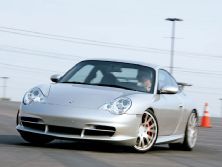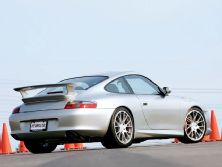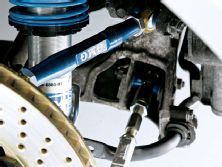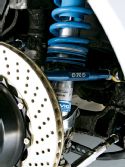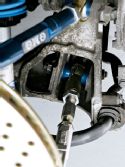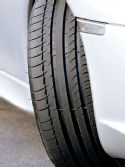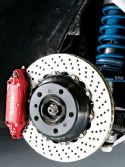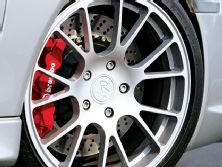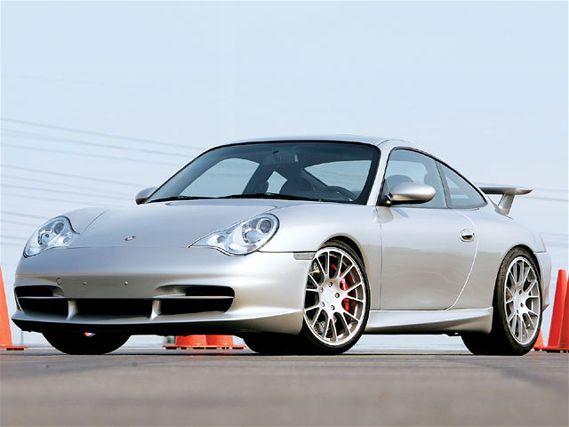 | Brembo, GMG & Rennworx Upgrades - Project Carrera GT3
| Brembo, GMG & Rennworx Upgrades - Project Carrera GT3
Throughout this project, the goal was to take a Porsche 996 Carrera 2 and transform it into a GT3 replica, using factory and Tequipment components. The car has turned out excellent, offering near-GT3 handling and fooling even trained eyes, aesthetically. After that success and a couple of track sessions, we decided to go to the next level in handling and braking performance.
The car needed to remain streetable, yet also have the chops for the track. So a wide range of adjustability was a priority, as well as components that could take the abuse of a full day of all-out driving. The first step to improved lap times is suspension modification and few tuners know how to dial in a 911 better than performance tuner GMG.
Keeping in the mind the brief of adjustability to different tracks and driving conditions, GMG sourced Bilstein PSS9s to handle the damping and spring rate. Allowing ride height adjustment as well as nine levels of compression and rebound damping adjustment make these units a fine addition to the project.
For a greater range of adjustment in the geometry, GMG manufactures its own line of suspension components. All mods are developed and proven on GMG's own World Challenge GT racecars. A rear toe-steer kit allows owners of lowered vehicles to revert to factory geometry settings. The rear dog-bone kit allows camber adjustment, while thrust arm bushings eliminate deflection during acceleration and braking. All GMG components replace the factory bushings with more precise spherical bearings and Teflon-lined Indy Car rod ends.
Key to all this available adjustability is proper set-up. Any shop could bolt on these components, but it takes an operation with years of experience like GMG to make everything work. Todd Ketchum, GMG Racing's crew chief (who has over 10 years of experience in SpeedGT and ALMS), did the corner-balancing and alignment. He used the in-house Beisbarth alignment machine, the same as Porsche uses. Ride height was set to European GT3 specs and the alignment is on the aggressive side of street numbers.
On the street, the car is now incredibly responsive. Turn-in is vicious. All factory bushing deflection is gone, translating every road nuance directly to the driver. Cornering forces are greater than a GT3 and it's even quicker to rotate.
With our suspension up to racing standards, we needed an appropriate tire. Initially, we wanted to use Michelin's amazing Sport Cup tire, but the proper size isn't currently available. Porsche fits Michelin Pilot Sport 2s to many of its models. Stiff sidewalls, minimal shoulder tread void and a sticky compound make them ideal for this application. This car will seldom see rain, but when it does, these tires will get the driver home.
For wheels, something lightweight, strong and aggressive-looking was on the wish list. Rennworx has just the thing. The RSL is a one-piece forged mesh-style wheel that looks as if it just came off the track. These items start at 18 pounds and are manufactured for an ideal fit on modern Porsches.
Originally, we decided on a 19-inch tire and wheel package for optimum brake clearance. An 18-inch set-up would have been more practical from a performance point of view, but would have looked more dated. The front wheel is 19x8 and wrapped in a 235/35/19, while the rear fenders are stuffed with a massive 19x11 wearing an equally substantial 305/30/19. With the giant sizes and serious rubber, Project GT3 will never want for more grip.
While stock Porsches have always had strong brakes, with this much handling potential, a larger, more hardcore system was deemed necessary. Brembo has recently updated its Grand Turismo brake kit for the 996. The front consists of a six-piston monobloc caliper and 15-inch two-piece floating discs. The rear four-piston units come with 13.5-inch two-piece floating rotors. Because of the lighter rotors, the kit is virtually the same weight as the factory parts, but provides substantially more braking power. GMG chose Castrol SRF brake fluid.
The brake pedal is firm, but doesn't seem to require any greater effort than stock. We thought the new suspension had a lot of feel, but the brakes are even more tactile. There is no dead space in the stroke, just instant pressure. These are the kind of brakes that provide the confidence to barrel toward a corner at 150-plus mph, knowing full well that if the pedal isn't there, you're going straight off.
Project GT3 is now a true track weapon. If we had it to do again, we would go with 18-inch wheels and leave the 19s for 997s and street cruisers. The ride is definitely firmer than before, but the Bilstein PSS9s have surprised even us. We expected more compromise from such a high-performance coilover, but they are bearable on the street. That said, we can't wait to take this thing back to the track.

